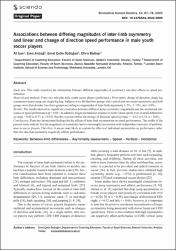Associations between differing magnitudes of inter-limb asymmetry and linear and change of direction speed performance in male youth soccer players
Özet
Study aim: This study examines the relationship between different magnitudes of asymmetry and their effects on speed performance.
Material and methods: Forty-two sub-elite male youth soccer players performed a 30-m sprint, change of direction, single leg
countermovement jump and single leg hop. Subjects were divided into groups with vertical and horizontal asymmetry, and both
groups were then divided into three groups according to magnitudes of inter-limb asymmetry (<5%, 5–10%, and >10%).
Results: The results showed no significant correlation between different jump asymmetry magnitudes and the mentioned outcomes of speed performance (p > 0.05). In addition, larger asymmetries resulted in faster linear speed, even if small differences
(g range = 0.00 to 0.57; p > 0.05). But this was not similar for change of direction speed (g range = –0.42 to 0.34; p > 0.05).
Conclusions: There are inconsistent findings for the effects of inter-limb asymmetries on speed performance. The results of the
present study indicate that the magnitude of asymmetry had no meaningful association with independent measures of performance in soccer players. Therefore, it seems more likely to explain the effects of individual asymmetries on performance rather
than the idea that asymmetry negatively affects performance.
Kaynak
Biomedical Human KineticsCilt
14Sayı
1Bağlantı
https://www.scopus.com/record/display.uri?eid=2-s2.0-85124263011&origin=resultslist&sort=plf-f&src=s&nlo=&nlr=&nls=&sid=20c4fe371b9b908d4f7e419f791331ff&sot=aff&sdt=cl&cluster=scofreetoread%2c%22all%22%2ct&sl=72&s=AF-ID%28%22Alanya+Alaaddin+Keykubat+University%22+60198720%29+AND+SUBJAREA%28MEDI%29&relpos=84&citeCnt=3&searchTerm=https://hdl.handle.net/20.500.12868/2409
https://sciendo.com/article/10.2478/bhk-2022-0009


















